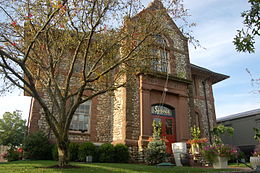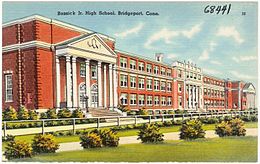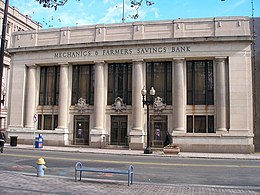| Revision as of 16:30, 20 March 2023 editJohnpacklambert (talk | contribs)Autopatrolled, Extended confirmed users, Pending changes reviewers602,860 edits removed Category:1873 births; added Category:1874 births using HotCat← Previous edit | Latest revision as of 10:17, 14 March 2024 edit undoInternetArchiveBot (talk | contribs)Bots, Pending changes reviewers5,387,709 edits Rescuing 1 sources and tagging 0 as dead.) #IABot (v2.0.9.5 | ||
| Line 23: | Line 23: | ||
| Having begun his practice by 1902, and continuing until his 1945 death, Ernest G. Southey had a career spanning almost the entire first half of the twentieth century. During that period, he designed a number of major residences, commercial buildings, and the ]. He was a member of the ] from 1916, and was cited for his architectural achievement during Bridgeport's centennial celebration in the 1930s.<ref>Withey, Henry F. and Elsie Rathburn Withey. ''Biographical Dictionary of American Architects (Deceased)''. 1956.</ref> | Having begun his practice by 1902, and continuing until his 1945 death, Ernest G. Southey had a career spanning almost the entire first half of the twentieth century. During that period, he designed a number of major residences, commercial buildings, and the ]. He was a member of the ] from 1916, and was cited for his architectural achievement during Bridgeport's centennial celebration in the 1930s.<ref>Withey, Henry F. and Elsie Rathburn Withey. ''Biographical Dictionary of American Architects (Deceased)''. 1956.</ref> | ||
| Southey's son, David Ludgate Southey (1911-1974), was also an architect.<ref>. ''http://public.aia.org/''. n.d. Web.</ref> | Southey's son, David Ludgate Southey (1911-1974), was also an architect.<ref> {{Webarchive|url=https://web.archive.org/web/20160304095552/http://public.aia.org/sites/hdoaa/Wiki%20Pages/ahd1042300.aspx |date=2016-03-04 }}. ''http://public.aia.org/''. n.d. Web.</ref> | ||
| At least one of his designs has been placed on the ], and several others are contributing properties in historic districts.{{citation needed|date=April 2022}} | At least one of his designs has been placed on the ], and several others are contributing properties in historic districts.{{citation needed|date=April 2022}} | ||
Latest revision as of 10:17, 14 March 2024
American architect (1874 - 1945)| Ernest Guy Southey | |
|---|---|
| Born | 1874 |
| Died | 1945 Bridgeport, Connecticut |
| Nationality | American |
| Occupation | Architect |
| Buildings | Bassick High School |




Ernest G. Southey (January 23, 1874 - November 20, 1945) was an American architect from Bridgeport, Connecticut.
Having begun his practice by 1902, and continuing until his 1945 death, Ernest G. Southey had a career spanning almost the entire first half of the twentieth century. During that period, he designed a number of major residences, commercial buildings, and the Bassick High School. He was a member of the American Institute of Architects from 1916, and was cited for his architectural achievement during Bridgeport's centennial celebration in the 1930s.
Southey's son, David Ludgate Southey (1911-1974), was also an architect.
At least one of his designs has been placed on the National Register of Historic Places, and several others are contributing properties in historic districts.
Works
- William N. Beardsley House, 135 Park Ave., Bridgeport, Connecticut (1902)
- Danbury High School, 181 White St., Danbury, Connecticut (1902) - Demolished.
- Westport Town Hall (Old), 90 Post Rd. E., Westport, Connecticut (1908)
- Bijou Theatre, 275 Fairfield Ave., Bridgeport, Connecticut (1910)
- Lewis B. Curtis House, 250 Waldemere Ave., Bridgeport, Connecticut (1910) - Demolished 1962.
- William L. Taylor House, 10 Soundview Rd., Westport, Connecticut (1910)
- City Savings Bank Building, 948 Main St., Bridgeport, Connecticut (1912–14)
- William B. Leigh House, 409 Waldemere Ave., Bridgeport, Connecticut (1913)
- Dudley M. Morris House, 305 Linden Ave., Bridgeport, Connecticut (1915)
- Casino, Seaside Park, Bridgeport, Connecticut (1918)
- Harvey & Lewis Store, 1148 Main St., Bridgeport, Connecticut (1918)
- Bridgeport Gas Light Building, 815 Main St., Bridgeport, Connecticut (1924)
- Morris Plan Bank Building, 102 Bank St., Bridgeport, Connecticut (1924)
- Alexander L. DeLaney House, 64 Lyon Ter., Bridgeport, Connecticut (1925)
- Bassick High School, Fairfield Ave., Bridgeport, Connecticut (1928–29)
- Mechanics and Farmers Savings Bank Building, 930 Main St., Bridgeport, Connecticut (1930)
- Bridgeport Hydraulic Building, 835 Main St., Bridgeport, Connecticut (1931)
- St. Vincent's Hospital (Completion), 2800 Main St., Bridgeport, Connecticut (1932) - Demolished.
References
- Southey, Ernest. "Ernest Guy Southey, Find-a-grave Memorial". Find-A-Grave.
- Withey, Henry F. and Elsie Rathburn Withey. Biographical Dictionary of American Architects (Deceased). 1956.
- "David Ludgate Southey (1911-1974)" Archived 2016-03-04 at the Wayback Machine. http://public.aia.org/. n.d. Web.
- "Marina Park Historic District NRHP Nomination". 1982.
- American Architect and Building News 17 May 1902: x.
- "Town Hall NRHP Nomination". 1982.
- Dunne, Susan. "A Restored Gem: Bridgeport's Bijou". Hartford (CT) Courant 2 Dec. 2011. Web.
- Witkowski, Mary K. and Bruce Williams. Images of America: Bridgeport on the Sound. 2001.
- "Compo/Owenoke Historic District NRHP Nomination". 1991.
- Palmquist, David W. Bridgeport: A Pictorial History. 1981.
- "Waldemere Hall". http://hcap.artstor.org/ . 2006. Web.
- Architecture Feb. 1915: 97.
- "Wistaria Hall". http://hcap.artstor.org/ . 2006. Web.
- "Seaside Park NRHP Nomination". 1982.
- American Contractor 22 June 1918: 52.
- Gas Industry 1924: 293.
- Sterner, Daniel. "Morris Plan Bank, Bridgeport (1924)". http://historicbuildingsct.com/. 20 Feb. 2012. Web.
- Bridgeport (CT) Telegram 29 Nov. 1924: 6.
- Iron Age 1928.
- ^ "Historic Resources of Downtown Bridgeport". 1987.
- Bridgemen's Magazine 1932: 293.